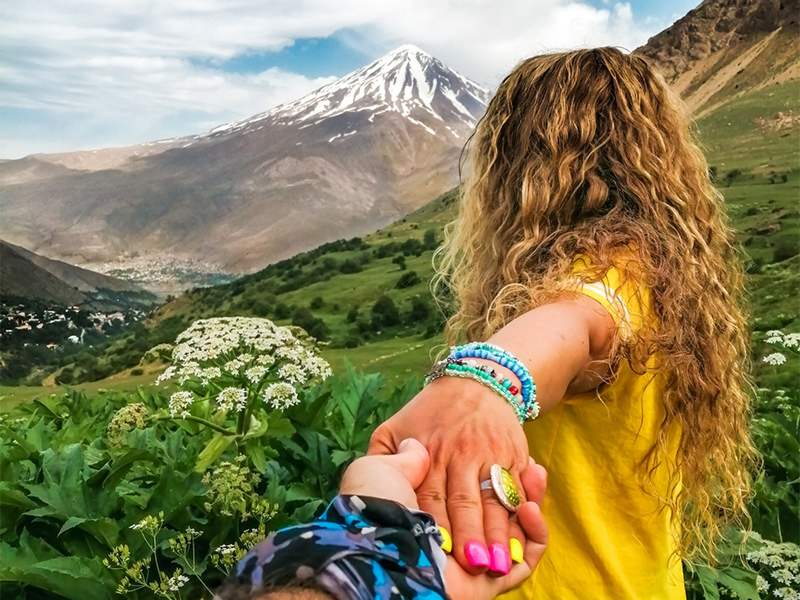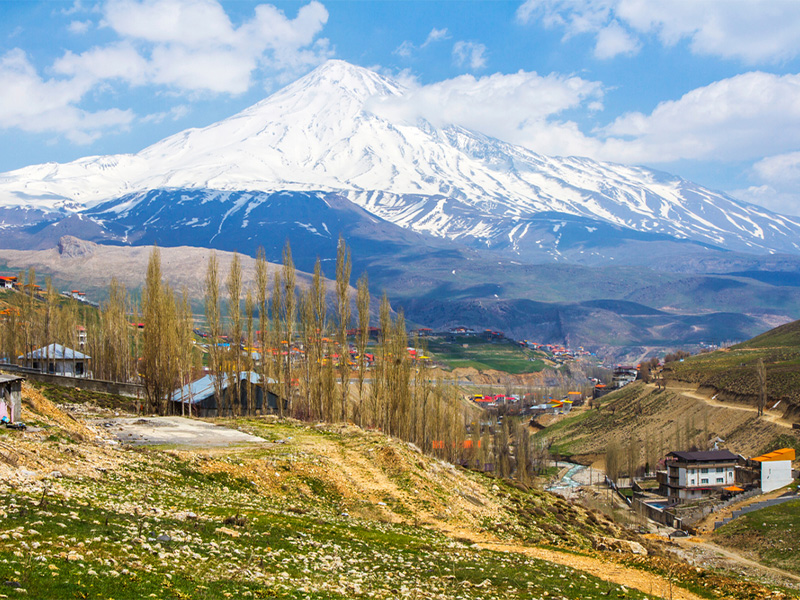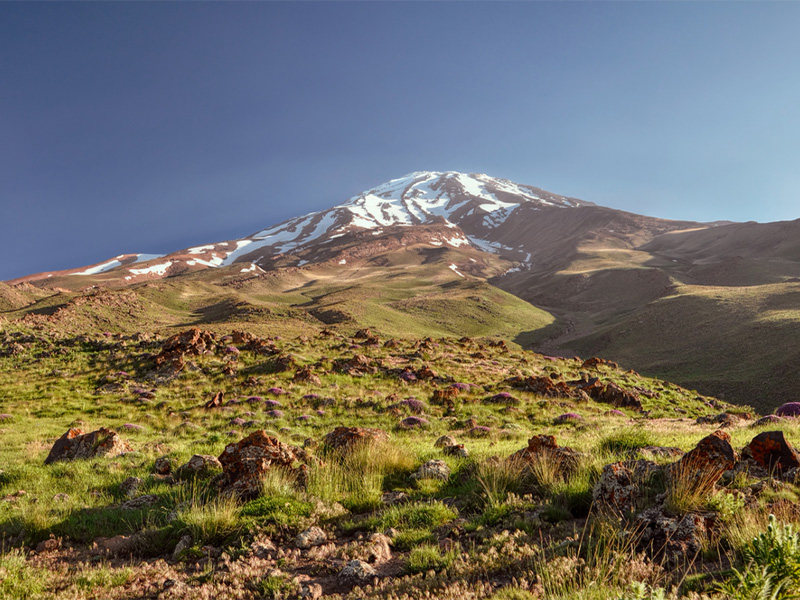Mount Damavand is considered the pride of Iran’s nature, and since 2008, it has been registered as the first natural heritage site in Iran’s national heritage list. With an elevation of 5,610 meters, it is the highest mountain in Iran and the Middle East, as well as the highest volcanic peak in Asia.
The first attempt to climb this peak was made by a man named Abudolf Khazraji in 341 AH (953 CE), and it is evident from his writings that he only reached certain parts of the mountain. However, fortunately, numerous groups exist today that have climbed this important heritage site, and relatively good information is available about the ways to climb Mount Damavand. Of course, to reach the peak, one needs to climb mountains of lesser elevation multiple times and receive training from professional mountaineers. In this article, we will attempt to outline the ways to climb Mount Damavand in general. Join us with Eligasht in this guide to climb Mount Damavand.
Book Iran Air flights from London to Tehran and Tehran to London and tehran hotel with Eligasht uk:
Mount Damavand – Climbing from the southern front
It can be said that this front is the oldest way to climb Mount Damavand, and mountaineers say it is also the easiest route. To access this route, you need to go to Polur and then to Rineh. After reaching the 65th kilometer of the Haraz road, you enter the village of Polur, then Lahr, and then change direction towards the Rineh road. In the middle of the road, you will see a dirt and rough path heading north, marked by a small sign indicating that it is about 6.5 kilometers from the base of the climb. The base of the climb to Damavand is from the southern part, starting from the Mosque of Saheb al-Zaman, and this area’s elevation is 3,000 meters.
Four-legged animals are available for locals to transport your luggage over this distance. You should start your path from the left side of an icy waterfall and after passing the third shrine, you will reach a sulfur hill that can be considered the result of the last small eruptions of Mount Damavand. It takes an average of about 4 hours to reach from the first to the third shrine. From the third shrine to the peak of Mount Damavand, it takes about 6 hours, depending on your speed and ability.

Climbing from the western front
This route is also one of the ways to climb Mount Damavand. If you want to go to the western front, you also need to go to the Haraz road, go towards Polur, and then enter the Lar Dam road. The base of this climb starts from a parking lot in the Varravar area, which is approximately 3,400 meters high. After reaching this point, you need to go towards the Simorgh shelter. The good feature of the Simorgh shelter is the presence of water.
Then you continue your path on the western ridge, where you will pass through the glacier and continue your path through the rocky and sulfuric soils. Mountaineers say that the slope of reaching the peak from the western front is very steep, but this may shorten the route. To reach the peak, you need to move towards the peak on this steep slope, which is even rocky. This route takes about 2 hours to reach the Simorgh shelter, and after that, the time to reach the peak varies depending on the slope, physical ability, breath, readiness, etc.
Mount Damavand – Climbing from the northeast front
It can be said that the northeast front, which is another way to climb Mount Damavand, is longer and higher than other routes. For this climb, mountaineers suggest two different routes. The village of Gazaneh is one of the routes that pass through the Taleghan River. The other option is through the village of Nandel. Of course, these two routes meet at the famous Takh-e Fereydoun shelter, and after that, climbing from the northeast front has a specific and uniform path. Some believe that climbing from the village of Gazaneh is longer, so they suggest the village of Nandel.
If you move from the village of Nandel, you can rent a Nissan or walk the path yourself. By car, you will reach the base of the climb, which is famous for Gousfandsara or Gardaneh Sar and is approximately 2,870 meters high, in about 45 minutes. If you go from Gazaneh, this route passes through the Taleghan River and passes through various fields until you reach the Espah spring. Then you have to reach Gousfandsara from the top of a hill under the Minar peak. After passing through a steep slope, you will reach the Fereydoun shelter. The continuation of this route reaches the northern front path at a point and reaches the peak together.

Mount Damavand – What equipment do I need?
you need to be prepared for zero-degree temperatures and even a few degrees colder for summer climbing to Mount Damavand, and bring enough clothing with you. Climbing Damavand does not require technical equipment, so you will not need equipment such as an ice axe, crampons, harnesses, rope, etc. in the summer. Among the most important items needed are:
- – Suitable mountaineering jacket
- – Mountaineering pants
- – Sunglasses
- – Headlamp
- – Backpack with a suitable size (40-50 liters is enough)
- – Mountaineering boots
- – Stove, fuel canister, and other cooking utensils
- – Lightweight and easily digestible food for two days
- – Hat
- – Gloves
what is the best route to climb Damavand?
The southern route is the most popular and recommended route for climbing Damavand. This route has several shelters and camps along the way, making it easier for climbers to rest and acclimatize. The southern route is less steep than the northern route and has a more gradual ascent, making it less challenging for inexperienced climbers.
When is the best time and season to climb Mount Damavand via the southern route?
The best time and suitable season for climbing Damavand is in August. In August, the temperature increases and the intensity of the winds around the peak decreases. During the last weekend of July and throughout August, Damavand, especially the main routes, is crowded unless the weather conditions are unstable. The reason for this crowding is the presence of mountaineering groups and inexperienced individuals aiming to increase their chances of a successful ascent. July and September are also suitable months for climbing, but you need to carefully monitor the weather forecast.
The weather on Mount Damavand in spring, autumn, and winter is very cold and exhausting for mountaineering. In spring, the weather on Damavand is very unstable, and at the same time as the air warms up, the risk of avalanches and rock and snow slides is serious, especially on the northern front. From mid-June and in snowy years, even sometimes in July, the conditions for normal summer ascents gradually become available.

Although the snowy mountain landscapes make winter or spring climbing to Damavand very attractive, many dangers are lurking for inexperienced climbers during these seasons. The air temperature at altitudes above 4000 meters of Damavand sometimes drops to -40 to -60 degrees Celsius (in winter) and up to -5 degrees Celsius (in summer). The wind speed on Damavand often reaches 100 kilometers per hour. Precipitation in Damavand’s highlands is usually heavy and occurs in the form of snow and blizzards.
Final words
climbing Mount Damavand can be a challenging and rewarding adventure for those seeking to test their physical and mental limits. The mountain offers stunning natural beauty, a rich cultural heritage, and a unique mountaineering experience. However, climbing Mount Damavand requires careful planning, preparation, and caution to ensure a safe and enjoyable climb.
Climbers should be aware of the potential risks involved in climbing, such as altitude sickness, harsh weather conditions, physical fatigue, rockfall, avalanches, and lack of experience. It’s essential to acclimatize properly, follow safety protocols, and have the necessary equipment and gear. Hiring a local guide or joining a guided tour can also help minimize the risks and ensure a safe and successful climb.
Despite the challenges, Mount Damavand offers a rewarding and unforgettable experience for those who are well-prepared and determined. Climbers can enjoy the stunning scenery, the sense of accomplishment, and the opportunity to connect with nature and culture. With proper preparation, caution, and respect for the environment, climbing Mount Damavand can be a life-changing experience.


1 comment
Hello my friend! I want to say that this post is amazing, nice written and
come witth almost all important infos. I would like to loook extra posts like this .